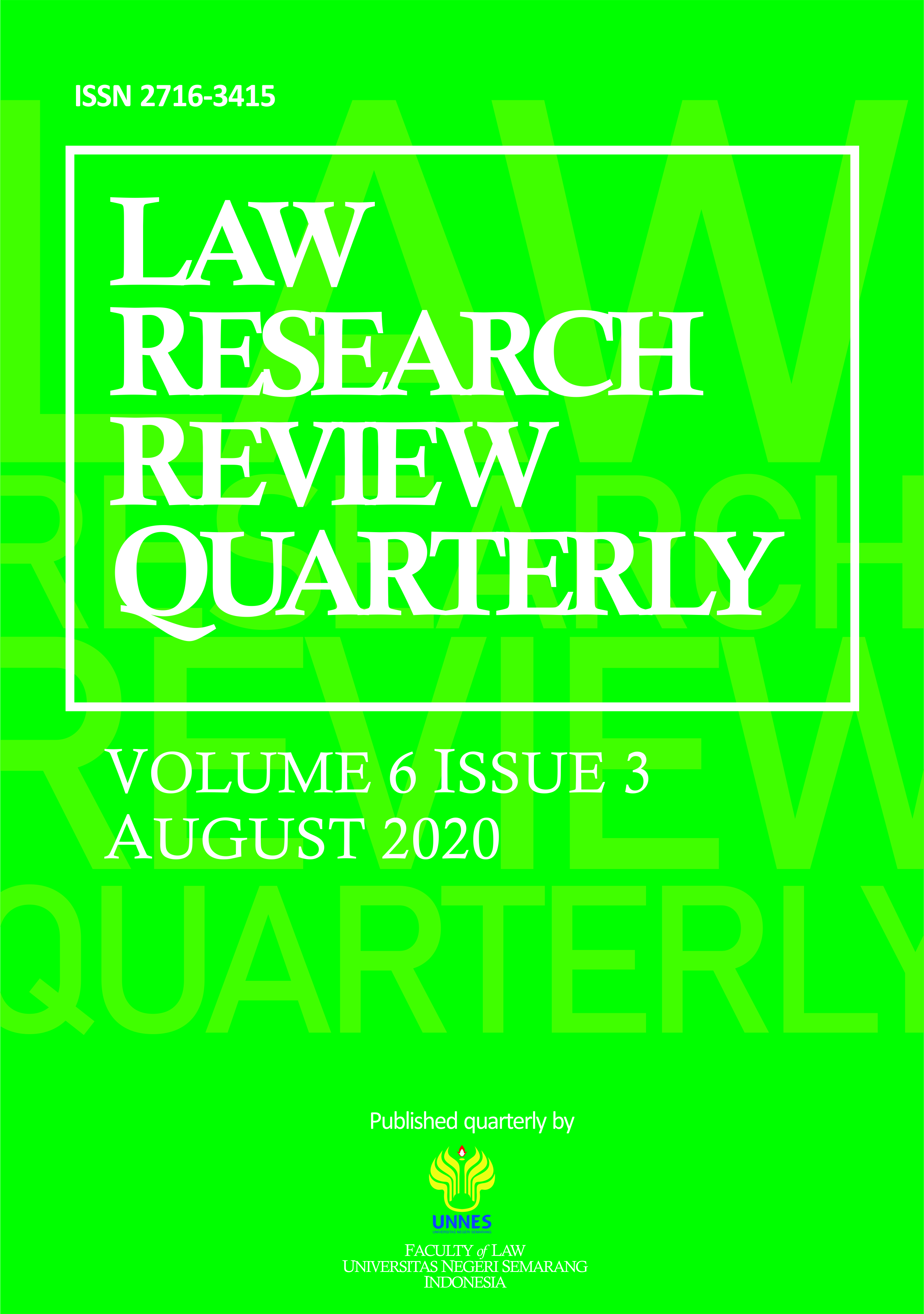Profiling Murder Prisoners in Criminology Studies at Kedungpane Class 1 Correctional Institution in Semarang
Main Article Content
Abstract
Murder is classified as a serious crime, because it takes a person's life and violates the most basic human right (right to life). This research tries to collect information in the form of the perpetrator’s personal data, what is the motive of the murder perpetrator, the motive, background and environment of a prisoner and tries to get information from prison officers about what are the parameters of an inmate who is ready to be released in social life and what efforts what the prison authorities do to restore the deviant behavior of a prisoner and direct them to return to acting according to the norms that exist in society and analyze all existing facts with theories from criminology. The research, which was conducted in the Kedungpane Correctional Institution Class I in Semarang, was intended to collect data, both from prisoners and prison officers. The research found several interesting facts about the perpetrator’s motive for killing were discovered. The research highlights if usually someone will kill someone because of revenge or economic pressure, labeling or labeling from the closest people also encourages the perpetrator to commit the crime of murder. Some of the sentences handed down to inmates can also be considered incompatible with their actions, so that the ruling party, who is the president, must make changes to several decisions on imposing criminal penalties as stated in the Criminal Code so that the law not only protects the community, but also provides true justice to the murderers.
Article Details
All writings published in this journal are personal views of the authors and do not represent the views of this journal and the author's affiliated institutions. Author(s) are retain the copyrights of the Article. However, before publishing, it is required to obtain written confirmation from Author(s) in order to ensure the originality (Author Statement of Originality). The statement is to be signed by at least one of the authors who have obtained the assent of the co-author(s) where applicable.This work licensed under a Creative Commons Attribution-ShareAlike 4.0 International (CC BY-SA 4.0)
References
Ali, A. (2008). Menguak Realitas Hukum Rampai Kolom dan Artikel Pilihan Dalam Bidang Hukum. Jakarta: Persada Media Grup.
Ali, Z. (2016). Metode Penelitian Hukum. Jakarta: Sinar Grafika.
Adami, C. (2010). Kejahatan Terhadap Tubuh dan Nyawa. Jakarta: Raja Grafindo Persada.
Gerungan, W. A. (2002). Psikologi Sosial. Bandunng: Refika Aditama.
Hajairin, H. (2017). Kriminologi Dalam Hukum Pidana. Yogyakarta: Suluh Media.
Suwardi, L. (1987). Metodelogi Penelitian Sosial. Medan: USU Press.
Moeliono, L. (2013). Analisis Data Kualitatif. Jakarta: Studio Teknologi Pendidikan Perpustakaan UnikaAtma Jaya.
Santori, D., & Komariah, A. (2009). Metodologi Penelitian Kualitatif. Bandung: Alfabeta.
Santoso, T., & Zulfa, E. A. (2010). Kriminologi. Jakarta: PT Raja Grafindo Persada.
Soekanto, S. (1986). Pengantar Penelitian Hukum. Jakarta: UI Press.
Utari, I. S. (2012). Aliran dan Teori dalam Kriminologi. Yogyakarta: Thafa Media.
Weda, M. D. (1996). Kriminologi. Jakarta: Raja Grafindo Persada.
Puspitasari, C. A. (2018). Tanggung Jawab Pemerintah Dalam Pelanggaran Hak Narapidana Dan Tahanan Pada Lembaga Pemasyarakatan/Rumah Tahanan Negara. Jurnal Panorama Hukum. Vol. 3 (1)
Heri Widiastono. 2007. Metodologi Penelitian Ilmiah dan Alamiah. Jurnal Pendidikan dan Kebudayaan. No. 068 th 13.
L Ross Matsueda. 1988. The Current State Of Differential Association Theory. Crime and Deliquency. Vol. 34 (3)
Laras Astuti. 2017. Eksistensi Keberadaan Lembaga Pemasyarakatan Dalam Sistem Peradilan Pidana di Indonesia. Jurnal Kosmik Hukum. Vol. 17 (1)
M. Delisi. 2001. Extreme Career Criminals. AM. J. Crime. Justice. Vol 25 (2)
Maryanto, dkk. 2014. Pelaksanaan Pembinaan Yang Bersifat Kemandirian Terhadap Narapidana Lembaga Pemasyarakatan Kelas II B Slawi. Jurnal Pembaharuan Hukum Vol. 1 (1)
Mehdi Mirzaei Alavijeh. 2015. Murder and Motivation: A Qualitative Study. Avicenna J Neuro Psych Physio. Vol 2 (2)
Mohammad Belayet Hossain dan Saida Talukder Rahi. 2018. Murder: A Critical Analysis of the Common Law Definition. Beijing Law Review.
MP Behnken dkk. 2011. Market for Death: An Emperical Criminal Careers analysis of Death Sentences in a sample of convigted male homicide Offenders. J.Crime Justice. Vol 39 (6)
Munawan. Peran Lembaga Pemasyarakatan Dalam Pembinaan Narapidana Dengan Sistem Pemasyarakatan. Jurnal Fakultas Hukum Universitas Tulung Agung.
Nia Amanda. 2017. Tinjauan Kriminologi Terjadinya Tindak Pidana Pembunuhan Berencana Dengan Mutilasi. Jurnal Unila.
Penny Naluria Utami. 2017. Keadilan Bagi Narapidana di Lembaga Pemasyarakatan. Jurnal Penelitian Hukum DE JURE. Vol 17 (3).
Prihatin Effendi. 2017. Motif Pelaku Dalam Tindak Pidana Pembunuhan Berencana Menurut Pasal 340 Kitab Undang-Undang Hukum Pidana. Jurnal Pro Hukum, Vol. 6 (2).
R. Donald Cressey. 1954. Differential Association Theory and Compulsive Crimes. The Journal of Criminal Law and Criminology. Vol. 45 (5)
Ralph D Taylor. 1995. The Impact of Crime on Communities. Annals AAPSS. Vol 539.
Robert Adelman dkk. 2017. Urban Crime Rates and The Changing Face of Imigration: Evidence across four decades. Journal of Ethmicity in Criminal Justice. Vol 15 (1)
Septiana Dwi Putri Maharani. 2016. Manusia Sebagai Homo Economicus: Refleksi
Atas Kasus-kasus di Indonesia. Jurnal Filsafat. Vol 26 (1)
Sudershan Pasupuleti dkk. 2009. Crime, Criminals, Treatment, and Punishment. Journal Of Contemporary Criminal Justice. Vol 25 (2)
Xavier Roseaux. 1997. Crime, Justice, And Society in Medieval and early modern times: Thirty Years Of Crime and Criminal Justice History. Open Edition Journal. Vol 1 (1)
Yerrico Kasworo. 2016. Pembunuhan Dengan Rencana Dan Pasal 340 KUHP. RechtsVinding Online.
Undang-Undang No.12 Tahun 1995 tentang pemasyarakatan.
